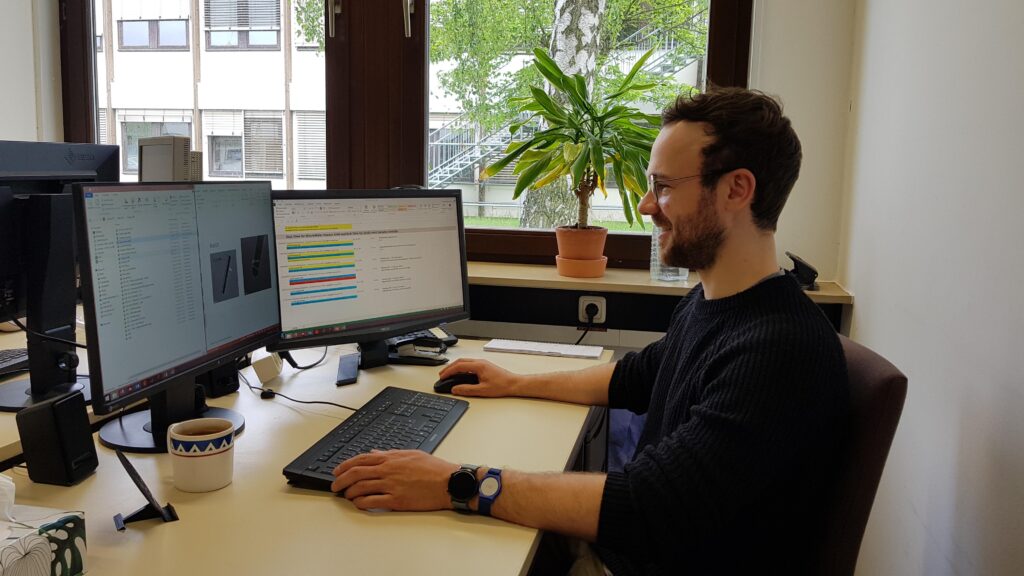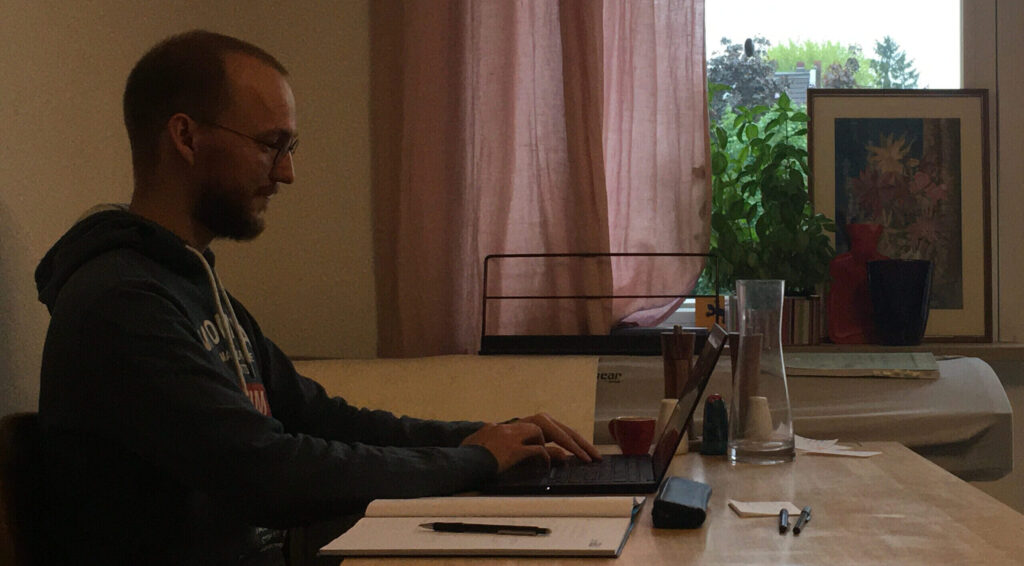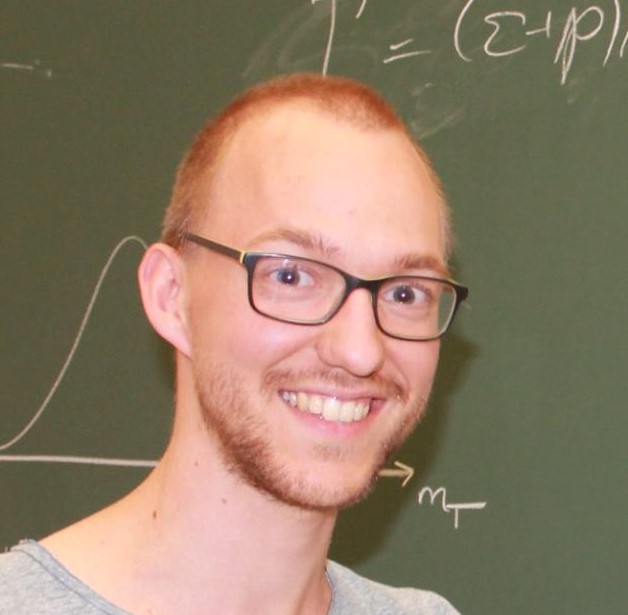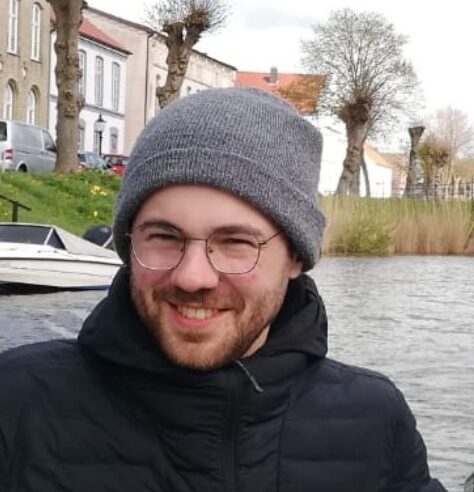
Hi, my name is Marvin Marco Jansen. I am working as a PhD student at the Forschungszentrum Jülich. My work focuses on the fabrication of single-photon sources in nanowires. This is one of the projects inside the ML4Q cluster and aims to create a communication/manipulation device to read/control quantum bits. Last year, I was able to publish a part of my work concerning the control of the crystal structure in nanowires.
This was my first publication and as it goes, it was not as I imagined at the beginning.
The experimental foundation
As an experimental physicist, the start of a paper is naturally the experiment. Last year, I was able to conduct multiple experiments analyzing the growth of Gallium arsenide (GaAs) nanowires. It was an experimental series combining multiple different single experiments. The preparation that goes into controlling the parameters necessary for this took me almost a year. Much longer than expected, of course, but finally it worked. This helped me to understand the crystal growth in much more detail and made it possible to aim to control this process. As we planned to start the next experimental series, the COVID-19 pandemic started and everything was shut down. Not only work was standing still, but also social life. It is a strange feeling to feel the need to isolate and not be close to your loved ones in order to protect them. It feels counterintuitive.
The analysis
However, it jump-started the next part of my work – the analysis. Luckily, I was able to take a lot of the necessary SEM and TEM images just in the week before the lockdown started. Being home now, with more than 300 individual images, I had nothing else to do but to start analyzing them, so I did. I looked at almost each and every nanowire that I photographed. I measured the length, the diameter, and the contact angle of these tiny tiny objects. Overall, more than 500 of them. Somehow, being home helped me to focus on this normally tedious task. But afterwards, of course, I had seen enough of these images for the near future! I had to focus on something else. Not able to perform any experiments, I took a deep dive into the current literature. And there it was – the paper I was waiting for! In this paper, people analyzed the crystal growth of the nanowires in real time. They also added videos to the paper. A fantastic work! You can see the nanowires growing like trees grow in a time lapse. They solved the remaining mystery to help me try the upcoming exciting experiments. I finally built a solid enough foundation and got the clues to try something new.
The real fun
As we learned to live with the pandemic and used distance, face masks and hand washing to effectively control the spread of the virus over the summer, work was possible again. Soon the Forschungszentrum opened. I was able to prepare my exciting new experiments in the clean room. It was very refreshing to be back at work, even if work was not like it was before. Empty offices, labs and no social gatherings. It was a weird feeling, but at least I was able to continue my work. The next experiments were the groundwork for my first paper. I simulated the amount of Gallium diffusion and impinging on the Gallium droplet on top of the nanowires. The droplet on top of the nanowire is called the growth seed. Here, Gallium and Arsenic Atoms combine at the liquid-solid interface and form the nanowire. A fantastic work last year found out that the angle between droplet and the nanowire rod determined the crystal structure of the nanowire. I wanted to control this in my next experiments by adjusting the amount of Gallium I introduce to the growth process. This was not tested like this before, and I was pretty excited.
Luckily and amazingly, it worked – I was able to control the crystal phase of the nanowires. So, I was able to start writing my first paper.
The writing part
The writing process itself was quite straight forward, but much longer than I expected. I wrote my first version of the manuscript, asked my colleagues for feedback. This was actually an interesting experience to see what other people focus on and how much work goes into each and every formulation and sentence in the paper. While I wrote the manuscript, we also checked all measurements, looked through the formulas and checked the simulation. There were a lot of very fruitful discussions. Even though it was not easy. This took several months. At the end of the process, the paper was much longer than previously expected, and I was at paper version 142 when we submitted the paper. Finally! The paper was ready. I booked a vacation to Austria and was ready for some hiking and not thinking about work. However, simultaneously and in the back of my mind the question if the paper will be accepted or not kept my mind quite busy. And when will the answer come? After one week? Two weeks?
At the end of the process, the paper was much longer than previously expected, and I was at paper version 142 when we submitted the paper. Finally!
Revision process
Two days after sending the paper away the answer arrived: No. We were not able to publish our paper at the desired scientific journal. I was crushed. I thought our findings were interesting enough to justify a publication at this journal. However, the direct No let me question this assessment.
Attached to the No, we were forwarded to another journal. At first, I did not like this idea and questioned the assessment of the editor. However, I had to admit that I do not know enough about this. They are the experts. Finally, we forwarded our paper to the next journal. This time, only a few days later we got the answer: Revision! I was not sure what a revision would mean, but after I saw the more than 50 comments I was shocked again! I was shocked by the enormous number of remarks. However, going through them one by one, I had to admit that most of the comments were really helpful and the reviewers addressed pretty good points. Of course, I have not agreed with all of the comments, but I was thankful for all revisions at the end. Finally, after addressing all comments and adding another experiments in just two weeks, the paper was accepted. Finally! The work of my colleagues and me would finally be made available for the whole scientific community. This was and still is an amazing feeling!
This time, only a few days later we got the answer: Revision! I was not sure what a revision would mean, but after I saw the more than 50 comments I was shocked again!
Looking back, I have to say that the paper writing process is a much longer and is more demanding than I expected before. Maybe this is only true for the first paper and with more experience the process becomes easier, but it was not as easy as I thought. I learned a lot and have to say that the exchange with my colleagues and the reviewers helped me to improve the quality of my experimental report in the end.
About Marvin
Marvin is a experimental physicist working on the realization of quantum information technologies at the Forschungszentrum Jülich. With his first publication in the bag, he is not slowing down and continues to search for new quantum phenomena wherever he can.
About the paper
Phase-Pure Wurtzite GaAs Nanowires Grown by Self-Catalyzed Selective Area Molecular Beam Epitaxy for Advanced Laser Devices and Quantum Disks
Marvin M. Jansen*, Pujitha Perla, Mane Kaladzhian, Nils von den Driesch, Johanna Janßen, Martina Luysberg, Mihail I. Lepsa, Detlev Grützmacher, and Alexander Pawlis*
ACS Appl. Nano Mater. 2020, 3, 11, 11037–11047

Although the overall concept of scientific publishing was omnipresent to me from early points in my studies onwards, there were multiple small details and not-so-small fundamental aspects I learnt when going through this process for the first time.
Expectations and trade-offs
A first basic aspect is the expectation of those that evaluate and receive the presented work, namely the peer referees at first and subsequently the readers. While constraints on time, personnel and computational resources are very much present when deciding the format and extent of published contents, the submitted manuscript is expected to cover a coherent set of the most relevant research questions, which is based on the nature of the subject and less on the available resources. This means that trade-offs between research questions have to be made by means of resource allocation, and that most likely a larger budget is necessary to fulfil all expectations. As a consequence, the outcomes of single steps (in my case numerical experiments) had an even larger influence on the trajectory and planning of the project.
This differs strongly from the expectation of referees for a (under)graduate thesis, which is evaluated under the awareness that a single person worked on it for a fixed time span and typically does not ask – or even allow – for extensions of any kind in order to optimally form a set of results. While the expectations and requirements in the publication process may put additional strain on the own timetable and budget, I experienced a related, more fundamental lesson when working towards the submission and resubmissions: The answers to single aspects of research questions did not – and to all I know will rarely – form a coherent, neat story on the matter in the way hypothesized at first. This required us to iteratively plan new experiments, adapt the questions we asked and reinterpret previous results and their importance in order to gain an overall understanding.
Of course this is a very important concept underlying the research process itself, but when we started working concretely towards the publication, evaluating our work from the perspective of a recipient and referee became more important and put additional emphasis on such ‘strategic’ aspects of the scientific process. In particular, I feel like this made me arrive at the right questions faster and keep an eye on the ‘big picture’ more consistently. Certainly, this may be typical when transitioning from an exploratory phase to the concrete setup of research questions, but I am sure this is a useful skill and habit in general.
When we started working concretely towards the publication, evaluating our work from the perspective of a recipient and referee became more important and put additional emphasis on such ‘strategic’ aspects of the scientific process.
The danger of the ‘streamlined story’
Overall the publication experience shaped my way of conducting research and – as it happens often – I already would have many things to tell my past self to improve on and which I try to implement in my current work. Despite these insights and their influence on both the research covered in my first publication and present work, the demand for a coherent, ‘streamlined’ story in scientific publications also raised some doubts in me: Whether the filter this demand puts on published outcomes might be too strong, encouraging researchers to sell their results as more monolithic than they are and to preferably pursue research questions with compatible answers. And whether the importance of negative results, in particular for young researchers and them constructing their intuition on research topics, might be underestimated both in scientific publishing and the community in general. I think it is very important to be aware of such incentives in the peer review process and to consciously avoid biases in our own research that may be caused by this.
Where do I click ‘hand in’?
Before receiving any feedback from peer referees, there were three tasks I did not have in mind while finishing up our paper: Choosing the journal to submit to, writing a letter to the editor and coming up with a collection of suggested referees.
While the first task is rather obviously necessary and I had witnessed quite some discussions about choices of journals, impact factors and the scientific publication press in general, I did not think about it until after the preprint submission. Our paper was well-suited for the journal we chose eventually, Physical Review Research, for the following reasons: First, we focused on evaluating proposed algorithms and their behaviour for different tasks and not so much on proposing a new algorithm or fundamentally new approaches to the topic. Second, in our methods section we aimed at making the background and the numerical setup understandable to a broad audience and at providing a complete picture of the task and the algorithms. This matches the scope of the journal very well. Third, all of us authors were in favor of making the paper openly accessible.
In hindsight, I fully understand why one writes a letter to the editor, but before the first publication I wasn’t aware of this concept.
I am glad that my supervisors decided to let me write it myself – with them providing some revisions – because this made me reflect on the scope of our work and consider the ‘big picture’ into which the paper would have to fit.
Lastly, I was very surprised that authors have the option of suggesting referees. While the idea of suggesting peers that might be most able to understand and review the work sounds good in the first place, I think that this is a danger for equal opportunities and fair career development. Typically, the suggested referees from the field will know articles beforehand because we use preprints, leading to biases in the peer review. The option to suggest referees favors researchers that are more established and already have larger professional social networks. In our case the journal has a wide scope across physics, such that suggesting referees within our field would not yield a representative review.
I am aware that the referee suggestions are what they are called – suggestions – and that the referees are chosen by the editor. Still I don’t think it is a good idea to introduce this bias and that the journal should be able to identify good referee candidates. We did not provide any suggestions.
On the bright side…
Regarding the publication process concretely, I gathered multiple, mostly positive insights:
First, the peer review provides valuable feedback both on the research and the chosen presentation. Independently of whether the publication was recommended or not, this helped me greatly to improve on evaluating research questions and on my scientific writing. As compared to the intense discussions and feedback from my supervisors and coauthors, the peer referees modeled a reader of the paper more realistically and mirrored their unbiased impression, even more so because we published in a cross-field journal.
Second, I was positively surprised by the referee reports. My expectations were rather low because of a plethora of stories, comments and jokes I had heard about the process and the stereotypical tone in the reports. These expectations turned out to be inadequate and as described above, I found the feedback very valuable and the quality of the paper improved drastically because of the review process – including a report that did not recommend our work for publication. The tone of the reports was very polite and professional, the correspondence was fact-based throughout and the level of detail surprised me very positively. I recall my first reaction to the report that discouraged publication to be very negative and emotional. In hindsight, I am sure that it was based on the rejection and that my negative expectations played a role in this as well, and I learnt that it is important to reflect my emotions towards my research and criticism.
Third, while I was positively surprised by the technical workflow for manuscript submissions and the integration with the arXiv preprint server, the final step of copy-editing was less fluent and seamless than I would have expected. In particular, the process could have been more transparent to save additional work and a software solution enabling authors to match journal requirements from the beginning might be possible and very helpful.
Overall, the publication process taught me many lessons regarding the particular project and our results but more generally regarding the scientific process, the presentation of ideas and results, and my personal relation towards my work.
About David
 David likes to code and was just curious to check out these optimization techniques used in variational quantum algorithms. He’s still checking…
David likes to code and was just curious to check out these optimization techniques used in variational quantum algorithms. He’s still checking…
About the paper
Avoiding local minima in variational quantum eigensolvers with the natural gradient optimizer
David Wierichs, Christian Gogolin, and Michael Kastoryano
Phys. Rev. Research 2, 043246 – Published 17 November 2020
